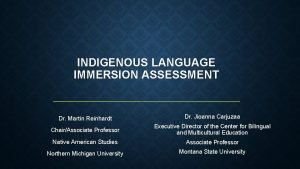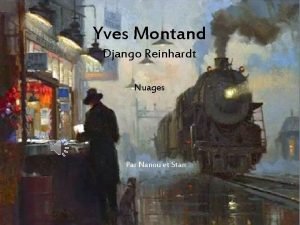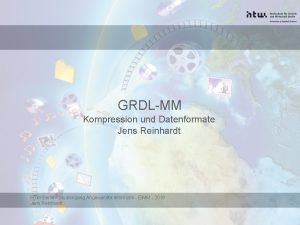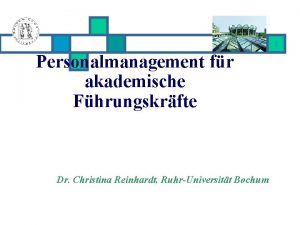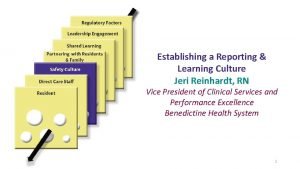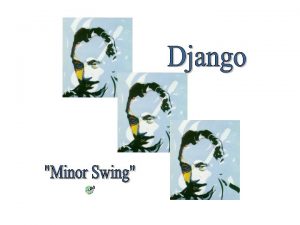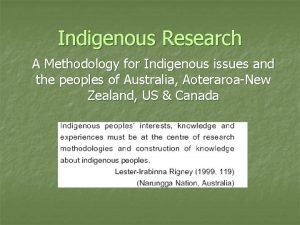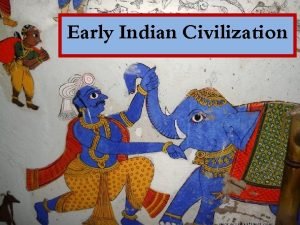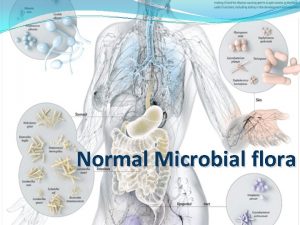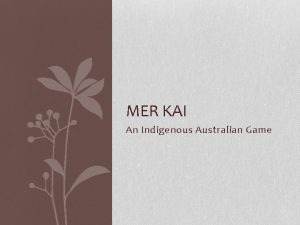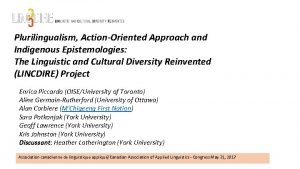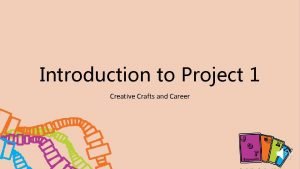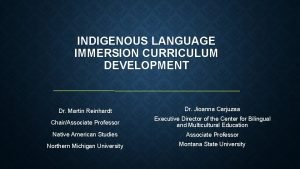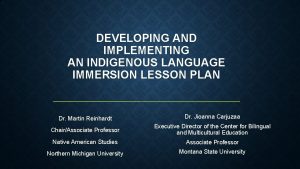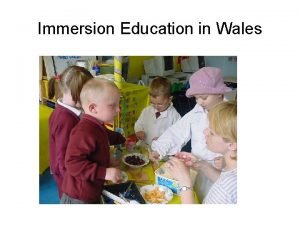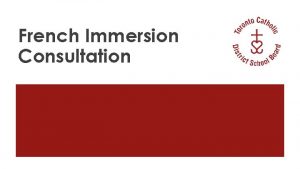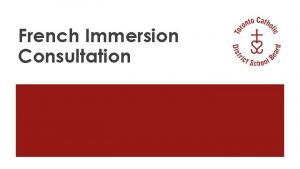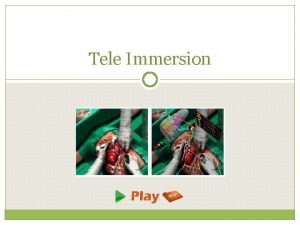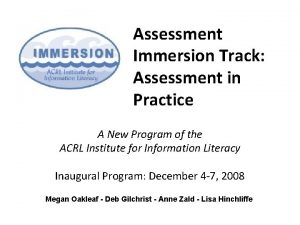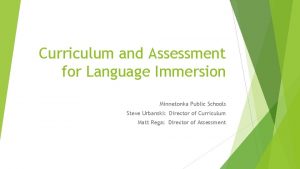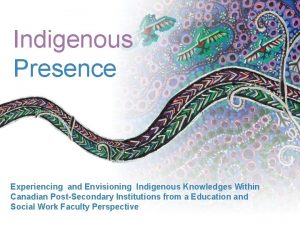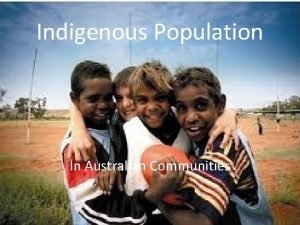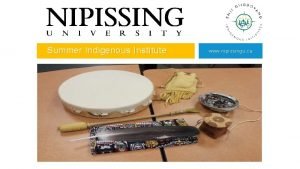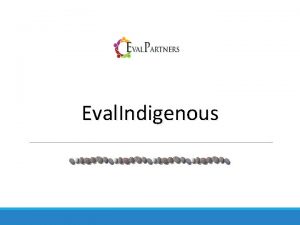INDIGENOUS LANGUAGE IMMERSION ASSESSMENT Dr Martin Reinhardt Dr



























- Slides: 27

INDIGENOUS LANGUAGE IMMERSION ASSESSMENT Dr. Martin Reinhardt Dr. Jioanna Carjuzaa Chair/Associate Professor Executive Director of the Center for Bilingual and Multicultural Education Native American Studies Associate Professor Northern Michigan University Montana State University

ABOUT THE PRESENTERS Dr. Martin Reinhardt Dr. Jioanna Carjuzaa Marty is an Anishinaabe Ojibway citizen of the Sault Ste. Marie Tribe of Chippewa Indians from Michigan. He has a Ph. D. in Educational Leadership from the Pennsylvania State University, where his doctoral research focused on Indian education and the law with a special focus on treaty educational provisions. His current research focuses on revitalization of traditional Indian education systems. Jioanna holds a Ph. D. in Multicultural, Social and Bilingual Foundations of Education from the University of Colorado Boulder. At MSU she serves as the Executive Director of the Center for Bilingual and Multicultural Education. She is grateful to serve as the facilitator for IEFA professional development opportunities, as the co advisor to American Indian Council, and as the faculty advisor for Wanji Oyate Education Cohort for Native students pursuing teaching careers. She is lead author of Teaching in the Middle and Secondary Schools, Pearson's leading methodology textbook which is now in its 11 th edition. She was the recipient of the 2013 G. Pritchy Smith Multicultural Educator of the Year Award.

ORAL PRODUCTION (SPEAKING) IN THE SECOND LANGUAGE CLASSROOM • Bilash (2009) suggests that when “planning speaking activities, teachers need to decide whether students need high structure (for example drills and controlled practice) [or] low structure (for example role plays, simulations). • She also suggests that teachers ask themselves the following questions: • Is it necessary to review the language to be used in a task? • Will the learners work in pairs or small groups? • How will learners be monitored as they complete task? • How will teachers provide feedback to students? • http: //www. educ. ualberta. ca/staff/olenka. bilash/best%20 of%20 bilash/speaking. html

METHODS OF ASSESSING STUDENT PERFORMANCE • Education Northwest (2014) recommends the following regarding assessment of student performance: • Assessment of student performance is carried out: • in the language of instruction • is based on the local curriculum • is used to adjust pedagogy and curricular approaches for individual students and classroom practice • Schools and parents monitor progress of both students and teachers for decisions on: • curricular • management • pedagogical changes

LANGUAGE IMMERSION ASSESSMENT RUBRICS • The Center for Applied Linguistics (CAL) provides examples of rubrics for assessing oral and written language skills development. (See Chapter 11) • Oral Skills: • • Comprehension Fluency Vocabulary Grammar • Written Skills: • • • Composing Style Sentence Formation Usage Mechanics

GRADE 1 ORAL LANGUAGE IMMERSION ASSESSMENT RUBRIC EXAMPLE Skill Components Comprehension 1 2 3 4 5 (circle one) low high Fluency 1 2 3 4 5 (circle one) low high Component Descriptors Comprehends speech at a normal rate of speed ___ Always ___ Most of the time ___ Much of the time ___ Sometimes ___ Rarely ___ With non verbal cues only ___ Uses native like flow of speech ___ Uses fluent connected speech, occasionally disrupted by search for correct form of expression ___ Speech is connected but frequently disrupted by search for correct form of expression ___ Uses simple sentences ___ Uses phrases and "chunks" ___ Uses one word/two word utterances ___ Silence Comments

ORAL LANGUAGE IMMERSION ASSESSMENT RUBRIC CONTINUED Skill Components Component Descriptors Vocabulary 1 2 3 4 5 (circle one) low high ___ Uses varied and descriptive language, possibly including native like phrasing and/or idiomatic expressions ___ Uses vocabulary sufficient to communicate in most social and academic contexts, with some varied and descriptive language ___ Uses vocabulary sufficient to communicate in most social and academic contexts ___ Uses vocabulary sufficient to express basic needs and feelings; responds to simple questions, with limited or no use of first language ___ Uses only basic vocabulary with possible heavy use of first language ___ Uses isolated words or sentence fragments ___ Uses native language only Comments

ORAL LANGUAGE IMMERSION ASSESSMENT RUBRIC CONTINUED Skill Components Grammar 1 2 3 4 5 (circle one) low high Component Descriptors Uses basic grammar; makes some errors which obscure meaning (Check only those areas that need work. ) ___ No oral production ___ Present tense ___ Past tense ___ Future tense ___ Complex verbal structures ___ Gender agreement ___ Singular/Plural ___ Subject verb agreement ___ Negations___ Adjective placement ___ Direct object pronouns ___ Prepositions ___ Articles Comments

GRADE 1 WRITTEN LANGUAGE IMMERSION ASSESSMENT RUBRIC EXAMPLE Skill Components Component Descriptors Composing 1 2 3 4 5 (circle one) low high ___ Develops a story/topic with supporting details ___ Writes about a topic with a central idea ___ Writes related sentences about a specific topic ___ Writes some related sentences and some unrelated sentences ___ Writes single sentence or unrelated sentences ___ Uses letter strings, labels and/or words only ___ Draws related to the topic Style NA Comments

WRITTEN LANGUAGE IMMERSION ASSESSMENT RUBRIC CONTINUED Skill Components Sentence Formation 1 2 3 4 5 (circle one) low high Usage 1 2 3 4 5 (circle one) low high Component Descriptors ___ Uses all types of sentences effectively ___ Uses different types of sentences ___ Writes simple sentences expressing complete thoughts ___ Writes simple sentences ___ Attempts to write sentences ___ Labels or writes words only ___ Uses letter strings and/or environmental print only ___ No evidence Makes correct singular/plural noun formations Circle one: Consistently, Usually, Sometimes, Seldom, No Evidence, Not Applicable Uses correct gender formations Circle one: Consistently, Usually, Sometimes, Seldom, No Evidence, Not Applicable Demonstrates awareness that articles and nouns should agree Circle one: Consistently, Usually, Sometimes, Seldom, No Evidence, Not Applicable Comments

WRITTEN LANGUAGE IMMERSION ASSESSMENT RUBRIC CONTINUED Skill Components Mechanics 1 2 3 4 5 (circle one) low high Component Descriptors Demonstrates knowledge of sound symbol correspondence Circle one: Consistently, Usually, Sometimes, Seldom, No Evidence, Not Applicable Uses capital letters at beginning of sentences Circle one: Consistently, Usually, Sometimes, Seldom, No Evidence, Not Applicable Uses capital letters with proper nouns Circle one: Consistently, Usually, Sometimes, Seldom, No Evidence, Not Applicable Uses correct final punctuation Circle one: Consistently, Usually, Sometimes, Seldom, No Evidence, Not Applicable Comments

DAKOTA/LAKOTA/NAKOTA LANGUAGE WORKBOOK • The Oceti Sakowin Education Consortium (2009) developed a workbook in an effort to standardize Dakota/Lakota/Nakota language for fluent Native language speakers. • The workbook separates the standards into the following grade level groupings: K 2, 3 5, 6 8, and 9 12. (pages 122 125) • Let’s try to align the K 2 grouping indicators for Standard 1 with the Center for Applied Linguistics example for oral language immersion shown previously.

STANDARD 1: SPEAKING LAKOTA/DAKOTA/NAKOTA LANGUAGES Students will be able to: K-2 1. Introductions Showing the value of Woohoda/woohola by using proper introductions Identity 1. K ‐ 2. 1. 1. Identify and introduce themselves appropriately. Society 1. K ‐ 2. 1. 2. Address people respectfully by kinship. Family 1. K ‐ 2. 1. 3. Use proper gender kinship terms for family.

STANDARD 1: SPEAKING LAKOTA/DAKOTA/NAKOTA LANGUAGES CONTINUED Students will be able to: K-2 2. Conversations Wohdakapi/Woglakapi Formal 1. K ‐ 2. 2. 1. Carry on a simple conversation in a formal setting. Informal 1. K ‐ 2. 2. 2. Carry on a simple conversation in an informal setting. Story telling 1. K ‐ 2. 2. 3. Retell a simple story in d/l/n language.

STANDARD 1: SPEAKING LAKOTA/DAKOTA/NAKOTA LANGUAGES CONTINUED Students will be able to: K-2 3. Mechanics Yatinsiya lakotiyapi Yatinsiya dakodiyapi Gender 1. K ‐ 2. 3. 1. Speak using correct gender markers appropriately for developmental age and setting. Dialects 1. K ‐ 2. 3. 2. Repeat appropriate dialect in their community. Word order 1. K ‐ 2. 3. 3. Describe the word order of the L/D/N language. Sound 1. K ‐ 2. 3. 4. Correctly enunciate the L/D/N language sounds.

STANDARD 1: SPEAKING LAKOTA/DAKOTA/NAKOTA LANGUAGES CONTINUED Students will be able to: K-2 4. Expressions Woawacin Tone of voice 1. K ‐ 2. 4. 1. Speak using appropriate tone of voice. Delivery 1. K ‐ 2. 4. 2. Display confidence when using the D/L/N language in a one ‐to- ‐one situation. 5. Vocabulary Wicoiye/Wicoie Words 1. K ‐ 2. 5. 1. Speak appropriate vocabulary needed for simple conversation according to developmental age.

STANDARD 1: SPEAKING LAKOTA/DAKOTA/NAKOTA LANGUAGES CONTINUED Students will be able to: K-2 6. Humor Woihaked Humor 1. K ‐ 12. 6. 1. Use humor in speaking.

DLN/CAL ALIGNMENT EXAMPLE DLN Standard 1 Indicators CAL Oral Identify and introduce themselves appropriately Comprehension: Is able to recognize the identification or introduction situation. Fluency: Is able to use simple, or more advanced, sentences within context. Vocabulary: Is able to use vocabulary sufficient to identify and introduce themselves. Grammar: Is able to use multiple components like tense, singular/plural, gender, adjective placement, pronouns, etc. Address people respectfully by kinship Comprehension: Knows when it is ok to address people based on kinship. Fluency: Is able to use simple or more advanced, sentences within context. Vocabulary: Is able to use vocabulary sufficient to respectfully address kinship. Grammar: Is able to use multiple components like tense, singular/plural, gender, adjective placement, pronouns, etc.

DLN/CAL ALIGNMENT EXAMPLE CONT. DLN Standard 1 Indicators CAL Oral Use proper gender kinship terms for family. Comprehension: Is able to differentiate and use proper gendered kinship terms appropriately. Fluency: Is able to use simple, or more advanced, sentences within context. Vocabulary: Is able to use vocabulary sufficient to properly differentiate between gendered kinship terms for family. Grammar: Is able to use multiple components like tense, singular/plural, adjective placement, pronouns, etc. along with gender.

DLN/CAL ALIGNMENT EXAMPLE CONT. DLN Standard 1 Indicators CAL Oral Carry on a simple conversation in a formal setting. Comprehension: Is able to initiate and respond to simple conversational cues in a formal setting. Fluency: Is able to use simple, or more advanced, sentences within context. Vocabulary: Is able to use vocabulary sufficient to carry on a simple conversation in a formal setting. Grammar: Is able to use multiple components like tense, singular/plural, gender, adjective placement, pronouns, etc. Carry on a simple conversation in an informal setting. Comprehension: Is able to initiate and respond to simple conversational cues in an informal setting. Fluency: Is able to use simple, or more advanced, sentences within context. Vocabulary: Is able to use vocabulary sufficient to carry on a simple conversation in an informal setting. Grammar: Is able to use multiple components like tense, singular/plural, gender, adjective placement, pronouns, etc.

DLN/CAL ALIGNMENT EXAMPLE CONT. DLN Standard 1 Indicators CAL Oral Retell a simple story in d/l/n language. Comprehension: Is able to retell a simple story, in part or in whole, based on verbal ques. Fluency: Is able to use simple, or more advanced, sentences within context. Vocabulary: Is able to use vocabulary sufficient to retell a simple story. Grammar: Is able to use multiple components like tense, singular/plural, gender, adjective placement, pronouns, etc.

DLN/CAL ALIGNMENT EXAMPLE CONT. DLN Standard 1 Indicators CAL Oral Speak using correct gender markers appropriately Comprehension: Is able to differentiate and use correct gender markers based on age and setting. for developmental age and setting. Fluency: Is able to use simple, or more advanced, sentences within context. Vocabulary: Is able to correctly use gender marker vocabulary sufficient to appropriate for developmental age and setting. Grammar: Is able to use multiple components like tense, singular/plural, adjective placement, pronouns, etc. along with gender. Repeat appropriate dialect in their community. Comprehension: Is able to repeat the dialect appropriate to their community when given choices. Fluency: Is able to use simple, or more advanced, sentences within context. Vocabulary: Is able to use sufficient dialectical vocabulary. Grammar: Is able to use multiple components like tense, singular/plural, gender, adjective placement, pronouns, etc.

DLN/CAL ALIGNMENT EXAMPLE CONT. DLN Standard 1 Indicators CAL Oral Describe the word order of the L/D/N language. Comprehension: Is able to correctly describe word order given choices. Fluency: Is able to use simple, or more advanced, sentences within context. Vocabulary: Is able to use vocabulary sufficient to describe word order. Grammar: Is able to use multiple components like tense, singular/plural, gender, adjective placement, pronouns, etc. Correctly enunciate the L/D/N language sounds. Comprehension: Is able to correctly enunciate language when given choices. Fluency: Is able to use simple, or more advanced, sentences within context. Vocabulary: Is able to use vocabulary sufficient to show that they are enunciating correctly. Grammar: Is able to use multiple components like tense, singular/plural, gender, adjective placement, pronouns, etc.

DLN/CAL ALIGNMENT EXAMPLE CONT. DLN Standard 1 Indicators CAL Oral Speak using appropriate tone of voice. Comprehension: Is able to use the correct tine of voice when given choices. Fluency: Is able to use simple, or more advanced, sentences within context. Vocabulary: Is able to use vocabulary sufficient to show use of correct tone of voice. Grammar: Is able to use multiple components like tense, singular/plural, gender, adjective placement, pronouns, etc. Display confidence when using the D/L/N language in a one ‐to- ‐one situation. Comprehension: Is able to differentiate between displaying confidence and not when using DLN language in a one to one situation. Fluency: Is able to use simple, or more advanced, sentences within context. Vocabulary: Is able to use vocabulary sufficient to display confidence in a one to one situation. Grammar: Is able to use multiple components like tense, singular/plural, gender, adjective placement, pronouns, etc.

DLN/CAL ALIGNMENT EXAMPLE CONT. DLN Standard 1 Indicators CAL Oral Use humor in speaking. Comprehension: Is able to differentiate between humorous and non humorous speech and use it to provoke laughter and/or provide amusement. Fluency: Is able to use simple, or more advanced, sentences within context. Vocabulary: Is able to use vocabulary sufficient to show use of humor in speaking. Grammar: Is able to use multiple components like tense, singular/plural, gender, adjective placement, pronouns, etc.

NOTE ABOUT INDICATOR 5 VOCABULARY WICOIYE/WICOIE (WORDS) • LDN 1. K ‐ 2. 5. 1. requires that the learner: • “Speak appropriate vocabulary needed for simple conversation according to developmental age. ” • Since vocabulary is a category that is assessed for each standard and indicator, we did not need to treat it separately.

REFERENCES • Arlington County. (1997). VA Spanish Partial Immersion Program Rubrics for Writing and Speaking in English and Spanish for Grades 1 5. http: //eric. ed. gov/? id=ED 421895 • Bilash, O. (2009). Oral Production (Speaking) in the Second Language Classroom. http: //www. educ. ualberta. ca/staff/olenka. bilash/best%20 of%20 bilash/speaking. html • Education Northwest. (2014). Working With Indigenous Communities–Evidence Blast. http: //educationnorthwest. org/resources/working indigenous communities%E 2%80%93 evidence bla • Oceti Sakowin Education Consortium. (2009). Dakota/Lakota/Nakota Language Workbook.
 Dr martin reinhardt
Dr martin reinhardt Django reinhardt nuage
Django reinhardt nuage Jens reinhardt
Jens reinhardt Dr. christina reinhardt
Dr. christina reinhardt Helge reinhardt
Helge reinhardt Django reinhardt documentary
Django reinhardt documentary Reinhardt cykler
Reinhardt cykler Pros and cons of dual language programs
Pros and cons of dual language programs Indigenous axiology
Indigenous axiology Medicine wheel colors order
Medicine wheel colors order Indigenous science
Indigenous science What is indigenous research
What is indigenous research What is indigenous research
What is indigenous research Indigenous knowledge systems tok
Indigenous knowledge systems tok Indigenous name for forced labour
Indigenous name for forced labour Indigenous aryans
Indigenous aryans World council of indigenous peoples
World council of indigenous peoples Potent defenition
Potent defenition Aboriginal simple machines
Aboriginal simple machines Diffusion of judaism ap human geography
Diffusion of judaism ap human geography What is indigenous flora
What is indigenous flora Kai game history
Kai game history Indigenous creative crafts module
Indigenous creative crafts module It is an indigenous dance from a certain race or country. *
It is an indigenous dance from a certain race or country. * Standpoint
Standpoint Indigenous science
Indigenous science Major indigenous settlements in tennessee
Major indigenous settlements in tennessee Introduction to indigenous creative crafts
Introduction to indigenous creative crafts
